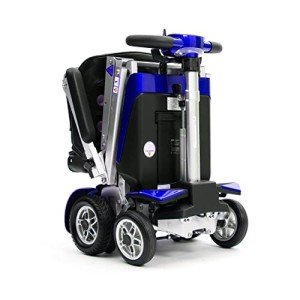A Comprehensive Guide to Buying a Mobility Scooter
Mobility scooters have ended up being an important tool for many people seeking to boost their independence and mobility. With a huge selection of designs and features readily available, selecting the right mobility scooter can be daunting. This post provides an informative guide to help customers browse their choices, assess their needs, and make a notified purchase.
Understanding Mobility Scooters
Mobility scooters are electric cars developed for people who experience mobility challenges. They are particularly beneficial for senior citizens, those with specials needs, or individuals recovering from injuries. Mobility scooters can vary widely in regards to design, features, and rates.
Kinds Of Mobility Scooters
Before embarking on a purchase, it's important to comprehend the different kinds of mobility scooters offered:
Three-Wheel Scooters:
- Generally more maneuverable in tight areas
- Lightweight and portable
- Suitable for indoor use
Four-Wheel Scooters:
- Offer higher stability and balance
- Suitable for outdoor use over numerous surfaces
- Typically have a longer battery life
Foldable/Portable Scooters:
- Designed to be quickly transported and saved
- Can typically suit the trunk of an automobile
- Ideal for those who take a trip often
Durable Scooters:
- Built to accommodate bigger people
- Frequently featured more robust features for outside use
- Generally equipped with larger batteries for extended range
Aspects to Consider When Buying a Mobility Scooter
1. Weight Capacity
Pick a mobility scooter that can support the user's weight. A lot of scooters have a weight limit ranging from 250 to 500 pounds. It is vital to guarantee that the scooter can accommodate the user comfortably.
2. Range and Battery Life
The range is how far the mobility scooter can take a trip on a single charge. Normal ranges vary in between 10 to 30 miles. Think about the user's day-to-day activities and choose a scooter with an appropriate range.
3. Scooter Dimensions
Consider the size of the scooter, including its weight and dimensions. A more compact scooter might be ideal for narrow corridors and tight spaces, while bigger models provide extra stability and comfort.
4. Terrain Capability
Assess where the scooter will mostly be utilized. If the user prepares to travel primarily on pavement, a lightweight design might be sufficient. Nevertheless, if the user requires to pass through gravel or irregular surfaces, think about a four-wheel scooter built for off-road usage.
Leading Features to Look For
Convenience
- Adjustable Seats: Look for scooters with cushioned and height-adjustable seats to make sure convenience during travel.
- Armrests: These enhance safety and assistance while navigating.
Safety and Visibility
- Headlights and Taillights: Essential for nighttime use.
- Turn Signals and Reflectors: Improve presence and safety while on the road.
User-Friendly Controls
- Joystick or Drive Controls: These should be instinctive and easy to manipulate.
- Easy-to-Read Displays: A control panel that reveals battery life, speed, and range can enhance the user experience.
Additional Features
- Storage Compartments: These offer included benefit for bring personal items while on the go.
- Weather condition Protection: Consider models with rain covers or windshields if used in variable weather.
Expense Considerations
When budgeting for a mobility scooter, prices can range anywhere from ₤ 500 to over ₤ 5,000 depending on the design, functions, and brand. Extra expenses might include:
- Extended Warranty: Protects against flaws and can save cash in the long run.
- Accessories: Optional features, such as upgraded seats, lights, or storage services.
| Function | Cost Range |
|---|---|
| Fundamental Models | ₤ 500 - ₤ 1,500 |
| Mid-Range Models | ₤ 1,500 - ₤ 3,000 |
| High-End Models | ₤ 3,000 - ₤ 5,000 |
Financing Options
Many retailers offer funding strategies, and some city government efforts may provide grants or assistance for those in need. Examine potential monetary assistance with neighborhood resources or mobility service companies.
FAQs about Buying a Mobility Scooter
What is the distinction between a mobility scooter and a wheelchair?
Mobility scooters are motorized and enable users to browse independently, while wheelchairs may require physical help or manual operation.
How do I preserve a mobility scooter?
Routine maintenance includes checking battery life, cleaning up the scooter, and inspecting tires and brakes. Always refer to the user manual for particular guidelines.
Can mobility scooters be used inside?
Yes, many models are designed for both indoor and outdoor usage. Nevertheless, three-wheel scooters tend to be much better fit for indoor navigation due to their tighter turning radius.
Are mobility scooters covered by insurance coverage?
Some insurance coverage plans cover a portion of the expenses for mobility scooters if they are considered medically needed. Contact your supplier for specific information.
How fast can a mobility scooter go?
A lot of mobility scooters have a maximum speed varying from 4 to 8 mph. Nevertheless, the appropriate pace may vary depending upon regional regulations.
Buying a mobility scooter can significantly enhance one's self-reliance and quality of life. By comprehending shop mobility scooters , features, and costs related to mobility scooters, prospective purchasers can make educated decisions that fit their needs and preferences. Customization and comprehensive research are essential to ensuring satisfaction with this important financial investment.

